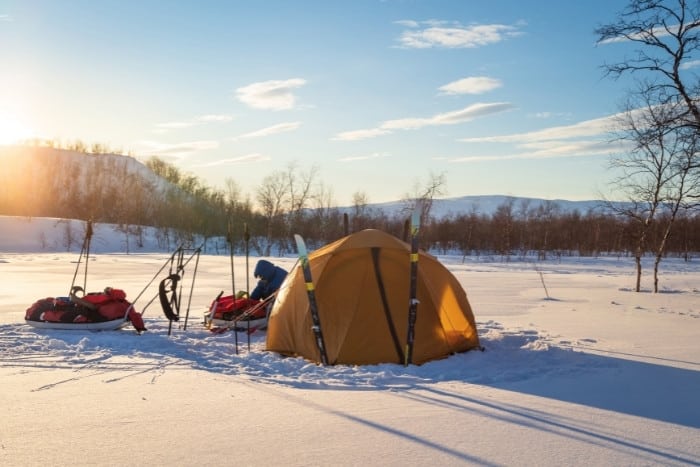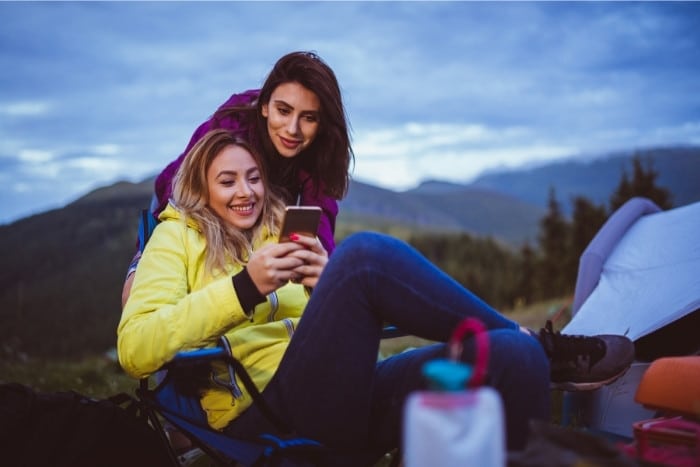You don’t want to give up camping just because the weather is getting a little colder. Maybe you relish the idea of solitude and some time to disconnect from the world, despite the winter season. The question is: is camping in winter a good idea?
Camping in winter can be a good idea, but you’ll have to do much more prep work. It’ll be less busy during this time of year, saving you money and giving you more solitude. It’s not a good idea to go camping in freezing temperatures (below 32F or 0C), even for experienced campers.
If you’re thinking about camping in the middle of winter, here is what you need to know to make your trip successful.
Can You Go Camping in the Winter?
For many campers, the lure of the wilderness is too much to resist, even when the temperatures start to drop.
Winter can be one of the most peaceful times to camp, especially because many novice campers pack up their gear for the season.
Many would-be campers’ problem is how they stay warm in the snow, ice, and freezing temperatures.
While you can go camping in the winter, it takes some extra preparation and supplies.
You should know exactly what the expected temperatures will be to pack accordingly. However, there’s still such weather that it is too cold for camping.
Most camping enthusiasts know that staying out in below-freezing temperatures (32F or 0C) isn’t a great idea.
Remember that nighttime temperatures are likely to be far colder than daytime temperatures. Always account for the forecasted low instead of just the high.
If you aren’t an experienced camper, freezing temperatures will likely be more extreme than you can handle.
Campers determined to go camping in winter need to answer some of these key questions before they head out.
1. Do You Have Enough Layers?
The key to staying warm during a brutal winter camping trip is to wear lots of layers.
You’ll want to wear something underneath your normal clothes, preferably something that fits tightly to your skin.
Layer a few pieces on top of each other and top them all off with something that will be weatherproof, waterproof, and windproof.
The wind can chill you to the bone, so you’ll always want to have on a layer that keeps the icy wind from cutting right through you.
Make sure to pack additional layers – even more than you think that you might need.
Once your base layer gets damp or sweaty, you’ll want to change it as soon as possible to keep warm.
Wet layers (especially cotton) can feel chill because water wicks heat away from the body.
Once you get too warm, remove layers to keep them from getting sweaty, making you feel a deeper chill.

2. What Will You Do About Bathroom Breaks?
Picture it: it’s the middle of the night and nature calls.
When camping in winter, nothing is less appealing than stepping outside your toasty sleeping bag and trekking into the woods just so you can pee.
Chances are that you don’t even want to leave your tent, much less take off your clothes so you can go to the bathroom.
Instead, you’ll have to learn to be okay with peeing in a (well-marked) bottle.
While this can be easier for men, women can learn to do it too with female urination devices.
They cost just a few dollars, but you’ll be grateful when the need to go arises in the dead of a winter night.
3. Do You Have the Right Gear?
If you’re going to be winter camping, you must ensure you have the right gear. First, think about what your sleeping bag is rated for.
This is where you’ll curl up nice and cozy when the sun goes down, and you want to ensure that it can adequately keep you warm all night long.
Check your current gear to see what your bag is rated for.
If it’s not low enough to accommodate the temperatures for your camping trip, invest in a liner that’ll score you another 10 degrees or so.
When this still won’t serve you well, buying a sleeping bag designed for freezing temperatures is worth the money.
Additionally, you’ll need a high-quality sleeping pad. During spring and summer camping, your pad is mostly designed for comfort.
Winter camping is a different ball game altogether.
A thick sleeping pad with an R-value of five or higher is essential. Sleeping pads keep you off the frozen ground and help insulate you.
4. Do You Know How to Set Up a Tent?
Before leaving for your winter camping expedition, ensure you’ve got all the equipment to properly set up a tent in the snow.
Double-check that your tent is sturdy and thick enough to help shelter you from the wind. Bring snow stakes to keep the tent in place.
However, you’ll also want to bring something to pack the snow.
If you aren’t careful to pack down the snow to form a platform for your tent, you might fall into holes and melt the snow with body heat.
Stepping in a soft spot where the snow isn’t packed down can even tear a hole in your tent. Instead, you’ll need to pack the snow down using snowshoes.
If you don’t have snowshoes, regular waterproof boots will also work, but it’ll take a little while longer.
5. Do You Have Hot Water Bottles?
As the temperatures drop for the night, you’ll want to ensure you do everything to stay warm.
Prepare for your winter camping trip by purchasing a few extra water bottles.
These can be filled with boiling water and slipped into your sleeping bag when you bed down. You don’t even need anything special.
A simple hard plastic water bottle will do the trick.
As you’re getting yourself situated for bed, tuck your water bottle between your legs to warm up the blood pumping through your femoral artery.
That’ll help you sleep soundly and stay warm for hours.
6. Where are Your Boots?
Even if you have waterproof snow boots, they can freeze if you aren’t careful.
For those who plan to go camping in the winter, invest in a pair of boots with removable liners to keep your toes as comfortable as possible.
Remove the liners from your boots and slip them into the bottom of your sleeping bag. This will keep them warm and dry overnight.
If you haven’t invested in a quality pair of boots with liners, remember that you don’t want to leave your boots outside the tent overnight.
Instead, you’ll need to store them in a waterproof bag that can be tucked into the bottom of your sleeping bag.
Ignoring this simple rule can result in frozen boots and cold feet in the morning.
If you aren’t careful, it can lead to frostbite and set you on the path to hypothermia.
7. Do You Know How to Pick a Campsite?
Camping during warm weather is easy: find a beautiful campsite and pitch your tent.
During the winter weather, you’ll have a much harder time settling on exactly where you should pitch a tent.
You want to find a spot that’s as sheltered as possible from the wind and one that doesn’t compound the cold.
First, you’re going to look for a campsite sheltered from the wind.
This might mean a spot near some trees or next to an incline that breaks some of the wind before it hits your tent.
Steer clear of pitching your tent on the top of a hill, as this is an open invitation to the wind.
On the same note, you’ll want to avoid camping at the bottom of the hill because cold air tends to linger in these depressions.
Once you find the right area, select a flat spot, pack down the snow, and stake it down to the best of your ability.

8. Is Your Tent Vented?
If cold weather is cutting into you, the last thing you want to do is open your tent up to the winter weather that surrounds you.
Unfortunately, this is a rookie mistake that many winter campers make when they first head out. Instead of closing the tent off, you actually want to vent it.
Why is that? When you breathe out throughout the night, you create a small amount of water vapor.
Those droplets will condense on the inner fabric of your tent.
If they’ve nowhere to go, the cold temperatures on the other side of even the sturdiest tent will turn those water droplets into little ice crystals.
Upon waking up, you’ll find that you’ve been sleeping in an ice cave, and it’s sure to feel chilly and uncomfortable.
Ice will melt when the sun rises, and temperatures rise, leading to wet supplies in your tent.
9. Did You Pack Enough Food?
Cold weather means your body will need to burn tons of calories to maintain its core body temperature.
As a result, you’ll need to pack more food than you usually eat. A hot meal will feel good, but it also takes your body a while to digest.
This results in warming you up from the inside out. Steer clear of sugary foods that are burned up quickly and don’t produce much body heat for you.
Instead, you should pack foods with high protein, fat, or carbohydrates because they require more work for your body to digest.
10. Did You Pack Enough Water?
If you’re trying to pack light for your winter camping trip, you might neglect to bring water due to its weight.
However, this is one item that you won’t want to skimp on. Pack as much water as you can carry because it’ll help keep you warm.
Even if you think that you might not want all of it, it’s important to drink even when you don’t feel particularly thirsty.
Water is used to help your body reach homeostasis. Suppose you don’t have enough water to drink.
In that case, your body will have a hard time reaching that consistent internal temperature, which can make you feel chilly and uncomfortable, even during the peak times of the day.
Remember that drinking lots of water means you’ll have to go to the bathroom more often.
Try to curb some of your drinking water around bedtime or have a pee bottle ready, so you don’t have to leave your tent in the dead of night.
11. Are You on a Budget?
One of the many benefits of camping during winter is that it’s less busy. Campgrounds see very little traffic when the temperatures start to drop.
Because they’ll have fewer guests, you may find campgrounds with much lower rates for the winter.
Some may even have free entry during winter, so look into it if you’re camping on a budget. Keep in mind that not all campgrounds are open past autumn.
Be sure to check in advance if the area you want to camp is available during the snowy season before you pack up the car and head out.
The good news is that you likely won’t need a reservation for a primo spot if they’re open.
12. Do You Have a Means of Communication?
Because you’re camping at a less popular time, fewer people are likely near your desired campsite.
If something goes wrong during your trip, there might not be anybody nearby that you can call to ask for help.
Always make sure you bring a means of communication or let friends and family know where you’re going camping.
Bring solar panels or another means of charging your phone if you won’t be camping somewhere with power outlets and electricity.
If you don’t have cell phone service in the part of the world where you’ll be camping, be sure to bring something else to help others find you.
This could be a whistle or flares that let other people know you’re out there and in need of help.
There are even offline messaging apps you can download before you go and use, similar to a walkie-talkie.

Final Thoughts
Camping in winter is great if you know how to adequately prepare for your excursion.
Knowing how to take care of yourself in the cold weather is essential, whether packing the right equipment, budgeting, or figuring out how to communicate with others if something goes wrong on your trip.
If you’re determined to go camping in the cold, addressing some of these common issues is essential to a successful trip.
